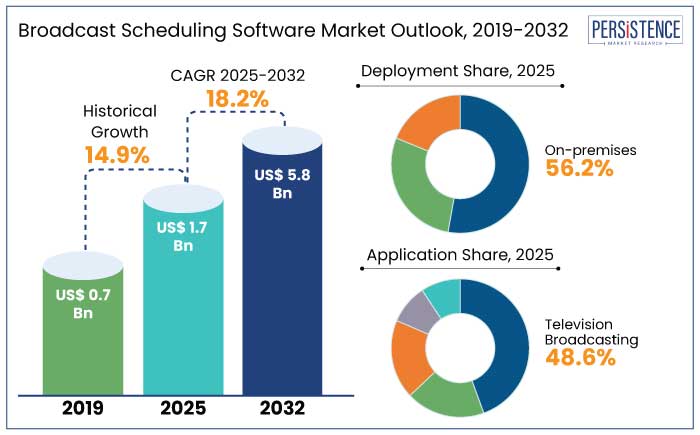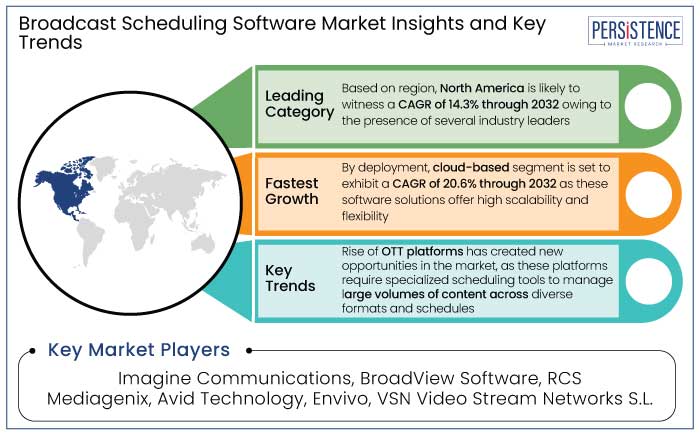Industry: IT and Telecommunication
Published Date: February-2025
Format: PPT*, PDF, EXCEL
Delivery Timelines: Contact Sales
Number of Pages: 189
Report ID: PMRREP35101
The broadcast scheduling software market is estimated to reach a size of US$ 1.7 Bn in 2025. The industry is anticipated to exhibit a CAGR of 18.2% through 2032 to attain a value of US$ 5.8 Bn by 2032.
As OTT platforms and digital channels become dominant, broadcasters require scheduling software that can manage content distribution across diverse platforms. Broadcast scheduling software is progressively being integrated with digital channels, streaming services, and media assets to optimize content delivery. By 2026, the integration with digital platforms is projected to increase by 20% year-on-year, driving the demand for sophisticated scheduling systems.
Cloud-based solutions are gaining traction as they offer scalability, flexibility, and cost-efficiency. This trend is particularly strong in small and medium-sized broadcast companies seeking affordable and scalable solutions. AI in broadcast scheduling assists in predicting peak viewership times and automating content release for maximum engagement.

Key Highlights of the Market
|
Market Attributes |
Key Insights |
|
Market Size (2025E) |
US$ 1.7 Bn |
|
Projected Market Value (2032F) |
US$ 5.8 Bn |
|
Global Market Growth Rate (CAGR 2025 to 2032) |
18.2% |
|
Historical Market Growth Rate (CAGR 2019 to 2023) |
14.9% |
North America broadcast scheduling software market is predicted to hold a share of 33.1% in 2025. The region is at the forefront of technological development in the media and broadcasting sector. Adoption of high-definition (HD) and ultra-high-definition (UHD) broadcasting standards has increased the demand for sophisticated scheduling software.
The presence of prominent players like Comcast, Disney, and WarnerMedia has driven the adoption of cutting-edge technologies. This in turn has necessitated the use of advanced broadcast scheduling software. This software is crucial for managing complex programming schedules, especially with the rise of multi-platform content distribution.
The U.S., particularly, has one of the highest rates of media consumption globally. The regions viewers are accustomed to accessing content across multiple platforms, including linear TV, streaming services, and online video platforms.
This complex media environment requires sophisticated broadcast scheduling software to optimize programming, avoid overlaps, and ensure the right content is delivered at the right time. The region’s diverse media landscape necessitates a robust software solution to streamline content delivery across these platforms, maximizing audience reach and engagement.
On-premises is anticipated to account for a share of 56.2% share in 2025. On-premises software enables broadcasters to have complete control over the environment in which their software operates.
Flexibility of on-premises solutions makes it easier to implement custom features, tailor workflows, and manage complex schedules. This level of customization is crucial for broadcasters that require specific functionalities.
On-premises solutions often offer higher reliability and performance. Broadcasters guarantee consistent performance during live broadcasts with on-premises systems. This is critical for maintaining high-quality content delivery. Broadcasters rely on the local infrastructure for tasks like transcoding, metadata management, and schedule updates without interruptions caused by network issues.
Security is a major concern for broadcasters, especially when dealing with sensitive data like viewer information, commercial agreements, and content rights. On-premises software offers better data protection as it is stored within the company's infrastructure.
Broadcasters can implement their own security measures, such as firewalls, encryption, and secure access protocols. Compliance with stringent data privacy laws, such as the General Data Protection Regulation (GDPR) in Europe or the California Consumer Privacy Act (CCPA) in the US, is easier to maintain on on-premises deployment. This is particularly important for broadcasters that operate internationally or deal with sensitive information regularly.
The cloud-based segment is projected to exhibit a CAGR of 20.6% through 2032. This surge is largely attributed to the increasing complexity of broadcast media planning.
Cloud-based broadcast scheduling software offers scalability, flexibility, and cost-effectiveness. This makes it an attractive option for broadcasters looking to streamline operations and decrease infrastructure costs.
Cloud-based systems’ ability to access and manage schedules remotely enhances operational efficiency, particularly in an era where remote work and decentralized teams are increasingly common. These systems also provide real-time data analytics and insights.
This further empowers broadcasters to make informed decisions about content scheduling and audience engagement. This capability is essential in today's competitive media landscape, where understanding viewer preferences and behavior is crucial for retaining audience share. For example, the U.S. Government Accountability Office (GAO) has highlighted that federal agencies are adopting updated strategies to enhance cloud computing services, with the aim of improving efficiency and reducing costs.
Television broadcasting is anticipated to maintain a dominant position with a share of 48.6% in 2025. Its extensive reach, established infrastructure, and the industry's ongoing demand for efficient content management solutions foster growth.
The widespread adoption of Direct-to-Home (DTH) services and satellite television has further reinforced the prominence of TV's. The vast array of channels requires sophisticated scheduling software to effectively manage programming, advertisements, and regulatory compliance.
Broadcast scheduling software enhances operational efficiency by automating program lineups, ad placements, and resource allocation. This automation minimizes human error and ensures seamless broadcasting, which is crucial for maintaining viewer satisfaction and meeting advertiser expectations.
In 2023, the software segment accounted for 73.4% of the broadcast scheduling software market's revenue. This robust growth was driven by the growing need for modern systems that streamline programming and ad placements.
Broadcast scheduling software ensures that programs, advertisements, and other media elements are broadcasted at the right time, to the intended audience, and in compliance with various operational and regulatory requirements.
User-friendly UI and enhanced UX in broadcast scheduling software is witnessing rising emphasis. Broadcasters are focusing on providing intuitive interfaces that require minimal training and enable quick navigation through complex scheduling tasks.
An improved UI ensures that broadcasters efficiently manage schedules, make changes, and access analytics without difficulty. This reflects the need for software that not only meets functional requirements but also enhances the overall user experience.
Modern broadcast scheduling software now includes enhanced analytics and reporting features, providing deeper insights into viewer engagement, ratings, and content performance. Analytics track peak viewing times, audience demographics, and the impact of specific programming changes.
The rise of multi-platform content delivery has necessitated the development of cross-platform scheduling tools within broadcast software. It ensures consistent programming across different platforms, enhancing viewer experience and engagement. Cross-platform scheduling also supports integrated marketing campaigns by aligning content delivery with digital advertising strategies.

The broadcast scheduling software market growth was steady at a CAGR of 14.9% during the historical period. The adoption of software solutions by media companies to streamline programming and automate workflows played a crucial role in expansion.
Growing volume of content across various platforms, including linear TV, online streaming services, and digital channels, necessitated advanced scheduling tools to maintain consistency and quality. Proliferation of digital media platforms, like video-on-demand (VOD) services and OTT (over-the-top) platforms, has been a prominent driver in the demand for broadcast scheduling software. The shift from traditional linear programming to a dynamic and flexible broadcast models has led to the adoption of automated scheduling solutions.
Growth in the forecast period is anticipated to be driven by the expansion of digital media platforms. The rise of hybrid broadcast models combining linear TV and streaming services is likely to foster expansion. Increasing demand for personalized content will be a key growth driver. The integration of AI and automation in broadcast scheduling software is likely to become prevalent in the forecast period.
Growing Demand for OTT Platforms
The proliferation of OTT platforms has introduced complexities in content scheduling and distribution. Traditional manual methods are inadequate for managing the vast array of content and the need for timely and platform-specific releases.
Broadcast scheduling software addresses these challenges by automating scheduling processes, thereby ensuring efficient content delivery and enhancing viewer engagement. For instance, broadcasters managing both traditional TV channels and multiple OTT platforms require sophisticated scheduling tools to seamlessly coordinate content releases.
Broadcast scheduling software enables the synchronization of content across various platforms, ensuring that audiences receive consistent and timely access to new releases. The software provides analytics and insights into viewer preferences and behaviors, enabling broadcasters to make data-driven decisions about content placement and timing. This capability is crucial in a competitive market, where understanding audience engagement leads to increased subscriber retention and revenue.
For example, user penetration in the OTT video segment is around 50% to 55%, with 90% of U.S. households subscribing to at least one streaming video service. Government initiatives promoting digital infrastructure and internet accessibility have further accelerated the adoption of OTT services in India and other emerging regions. As more consumers gain access to high-speed internet, the demand for diverse and readily available content continues to rise, necessitating efficient scheduling solutions to manage the expanding content libraries of OTT platforms.
Growth of Multilingual Broadcasting
Rise of digital platforms has made it easier for broadcasters to reach audiences far beyond their original geographic boundaries. As content consumption patterns change, broadcasters increasingly produce content in multiple languages to cater to non-native speakers. This expansion requires sophisticated software solutions that are capable of handling various languages and time zones, ensuring consistent and timely programming worldwide.
Broadcast scheduling software has become crucial for managing multilingual content due to its ability to automate scheduling tasks. These tools efficiently handle the complexities of multilingual programming, including language switching, dubbing, subtitling, and regional adaptations.
The increasing consumption of content from platforms like Netflix, which offers subtitles in multiple languages, highlights the need for sophisticated scheduling software. According to Digital TV Research, Asia Pacific is projected to have 687 million SVOD (Subscription Video on Demand) subscriptions by 2029. This growth underscores the demand for multilingual content and the software solutions required to manage it.
Governments are also recognizing the importance of multilingual content for social inclusion and cultural preservation. The EU’s Broadcasting Regulation promotes multilingual content by encouraging broadcasters to provide programming in different languages, thereby driving the demand for scheduling tools that accommodate this diversity.
Integration with Evolving Transmission Standards
Broadcast scheduling software must seamlessly integrate with different transmission formats, such as SD, HD, UHD, and emerging technologies like 5G broadcasting. As new standards are introduced, broadcasters need to update their software to ensure compatibility, which is both costly and time-consuming.
For instance, software that isn't updated to handle HDR (High Dynamic Range) or advanced compression technologies results in reduced quality of service and viewer dissatisfaction. Frequent updates and maintenance also impact operational efficiency.
Broadcasters often face downtime during updates, disrupting scheduling workflows and potentially leading to errors in programming. This downtime affects live broadcasting schedules, causing inconvenience to viewers and potential audience loss.
According to U.S. Federal Communications Commission (FCC), broadcasters in the U.S. were mandated to upgrade their transmission equipment to support ATSC 3.0 by 2023, which required significant software updates. This transition led to temporary disruptions, demonstrating the challenges broadcasters face in maintaining operational efficiency amid frequent updates.
The cost implications of such updates are considerable. Broadcasting is a capital-intensive industry, and the ongoing expenditure on software updates can strain budgets. Broadcasters must invest in both software updates and skilled personnel to manage these changes effectively.
Impact of Ad Inventory Optimization
Ad inventory optimization is revolutionizing broadcast scheduling software by enhancing efficiency, maximizing revenue, and enabling precise audience targeting. This process involves strategically managing and allocating advertising slots to ensure optimal use of available airtime, thereby increasing profitability for broadcasters.
In India, advertising revenue is projected to reach US$ 3.9 billion by 2025. To capitalize on this anticipated growth, broadcasters are increasingly adopting advanced scheduling software equipped with ad inventory optimization capabilities.
Modern broadcast scheduling software, such as WideOrbit’s platform, offers comprehensive ad management solutions that streamline sales operations, traffic, and billing processes. These systems enable broadcasters to automate ad placement, thereby decreasing manual errors and ensuring that inventory is utilized efficiently.
The rise of addressable TV advertising is further driving the need for sophisticated scheduling tools. Addressable advertising enables targeted ad placements based on viewer demographics and behaviors, necessitating software that can manage complex scheduling and inventory demands.
For instance, ADvendio’s ad inventory management software provides real-time availability of products and booking information across various media inventories. By reducing manual processes and minimizing the risk of double bookings, such tools enhance operational efficiency and allow broadcasters to focus on strategic initiatives.
Use of AI and Machine Learning for Effective Content Scheduling in Hybrid Models
AI and ML algorithms enable broadcasters to analyze vast amounts of viewer data to offer personalized content recommendations. By understanding viewer preferences, these systems can effectively schedule shows and advertisements, ensuring that the content reaches the right audience at the right time.
For instance, streaming platforms like Netflix and Amazon Prime Video use AI-driven algorithms to recommend content, enhancing user satisfaction and engagement. Broadcasters are adopting similar techniques, using AI to tailor their schedules based on past viewing patterns and demographic data. This helps retain viewers and increase loyalty.
Hybrid broadcasting models, which integrate linear broadcasting with digital streaming, are made more effective through the use of AI and ML. These technologies enable broadcasters to adjust content in real time, like breaking news updates, sports results, or last-minute schedule changes.
This capability is crucial for events with dynamic schedules, such as sports tournaments or live news coverage. For instance, broadcasters can use AI to quickly replace pre-scheduled programming with live updates during significant events, thereby maintaining viewer interest and relevance.
Companies in the broadcast scheduling software industry are continuously investing in research and development activities to develop advanced features such as automated scheduling, AI-based content recommendations, and predictive analytics. These innovations not only enhance operational efficiency but also provide broadcasters with the ability to optimize content placement, maximize viewership, and increase advertising revenue.
Companies often collaborate with content providers, media companies, and technology partners to integrate additional features such as media asset management, digital rights management, and real-time analytics. These partnerships enhance the value proposition of the software by providing a seamless experience for broadcasters, thereby decreasing integration costs and improving workflow efficiency.
Recent Developments in the Broadcast Scheduling Software Market
|
Attributes |
Details |
|
Forecast Period |
2025 to 2032 |
|
Historical Data Available for |
2019 to 2023 |
|
Market Analysis |
US$ Billion for Value |
|
Key Regions Covered |
|
|
Key Market Segments Covered |
|
|
Key Companies Profiled |
|
|
Report Coverage |
|
|
Customization & Pricing |
Available upon request |
By Solution
By Deployment
By Application
By Region
To know more about delivery timeline for this report Contact Sales

The broadcast scheduling software industry is estimated to reach a size of US$ 5.8 Bn by 2032.
Growth in the industry is propelled by increasing demand for efficient content management, automation, and optimization of broadcast schedules to enhance viewer engagement and operational efficiency.
Imagine Communications, BroadView Software, RCS, Mediagenix, Avid Technology, Envivo, VSN Video Stream Networks S.L., PlayBox Technology, and Sinclair Broadcast Group are the leading players.
The market is projected to record a CAGR of 18.2% through 2032.
A prominent opportunity lies in rising integration with over-the-top (OTT) platforms and digital streaming services.